Key takeaways:
- Inclusivity in promotions fosters community and connection, emphasizing the importance of representation and celebration of diverse perspectives.
- Identifying barriers involves self-reflection and recognizing the absence of visibility for marginalized voices, necessitating proactive strategies to support them.
- Engaging underrepresented artists in collaboration and mentorship can enhance creativity and enrich the promotional landscape.
- Measuring the success of inclusivity efforts includes tracking engagement metrics, gathering feedback from artists, and fostering community discussions on representation.
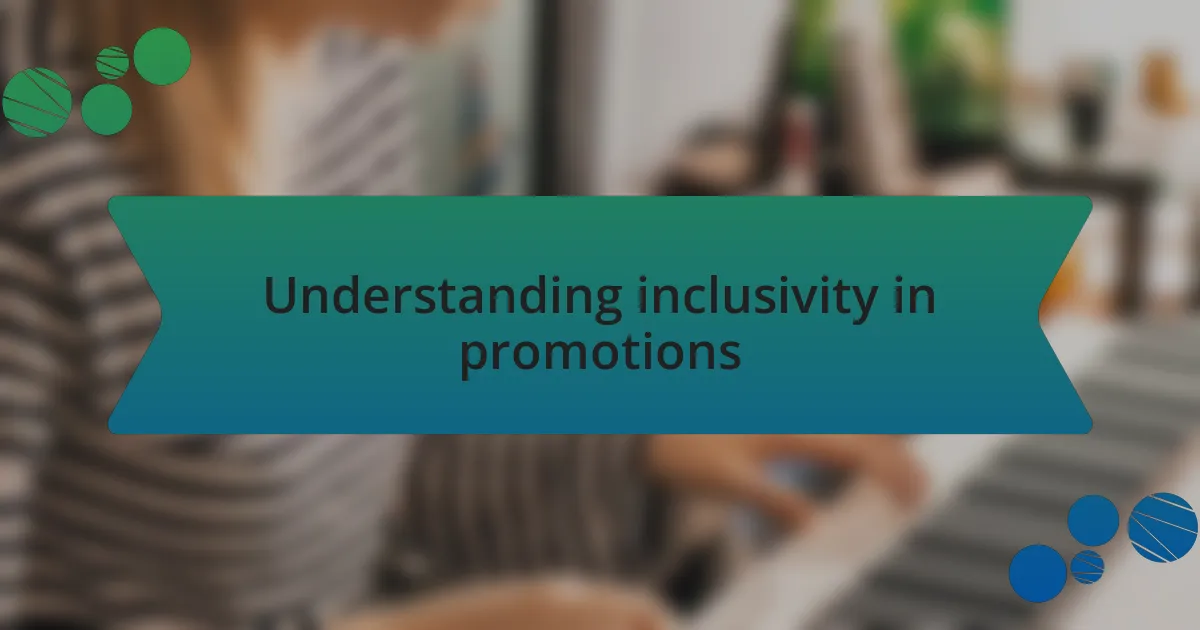
Understanding inclusivity in promotions
Inclusivity in promotions goes beyond mere representation; it’s about creating a space where everyone feels welcomed. I remember a time when our label organized an event that featured artists from diverse backgrounds. The energy in the room shifted; people connected over shared experiences, and it was clear how much diversity enriched our gathering.
When I consider inclusivity, I often ask myself, “Who am I leaving out?” This question helps me critically evaluate our promotional strategies. I recall a campaign we ran that highlighted lesser-known local talents. The positive response from the community was overwhelming, and it made me realize that inclusivity didn’t just benefit those being promoted; it fostered a stronger community around our brand.
It’s essential to understand that inclusivity also means acknowledging and celebrating differences in perspectives. I once heard from an artist how difficult it was to break into the scene due to lack of visibility. Their story resonated deeply with me, illustrating the importance of not just including a variety of voices but truly elevating them, ensuring everyone has a chance to shine. Each promotion can be a step towards greater understanding and connection in the electronic music community.
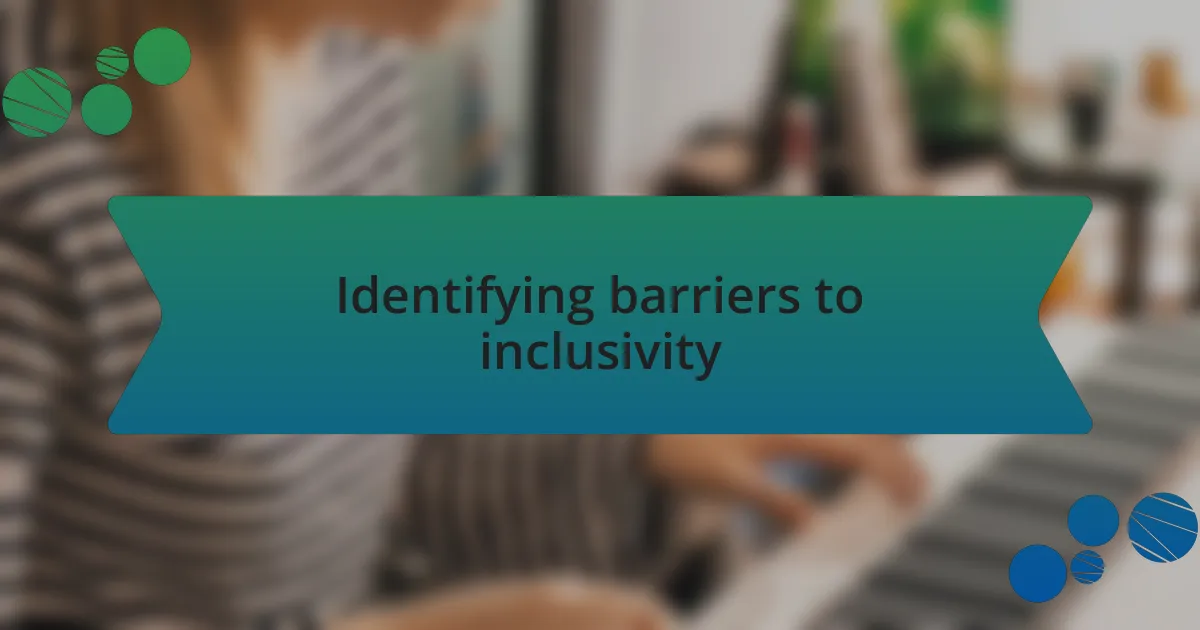
Identifying barriers to inclusivity
Identifying barriers to inclusivity often requires us to look inward and confront our assumptions. I recall an instance where I noticed our promotional materials predominantly featured a single demographic. It struck me that, while unintentional, this oversight created an invisible barrier for various groups who might not see themselves represented. How many potential fans and artists were we alienating simply by not showcasing the diversity that exists in our community?
Another significant barrier I’ve encountered is the lack of platforms for marginalized voices. During a brainstorming session, someone pointed out that we had great content but limited access for those who were not already in the spotlight. This made me rethink how we could leverage our channels to support those artists who are often overlooked. I began to wonder: what innovative formats or collaborations could we introduce to give everyone a fair chance?
Additionally, emotional and psychological factors play a role in inclusivity, as I’ve learned from various artists’ journeys. There was a time when an artist confided in me about feeling discouraged because they perceived our label was only interested in established names. This conversation opened my eyes to the self-doubt many talented musicians experience. It’s crucial to create an environment where everyone knows their voice matters, transforming those feelings of insecurity into a sense of belonging within the electronic music scene.

Strategies for enhancing inclusivity
One effective strategy for enhancing inclusivity is to actively seek input from diverse voices within our community. I remember hosting a meeting where we invited artists from underrepresented backgrounds to share their thoughts on our promotional approaches. Their perspectives were eye-opening, revealing ways we could tailor our messaging and outreach to ensure a broader range of experiences is highlighted. Why wait for feedback when we can proactively invite it?
Additionally, I’ve discovered that creating mentorship programs can have a profound impact. In one instance, I partnered with a seasoned producer to guide emerging artists through the intricacies of the industry. This initiative not only empowered those new to the scene but also fostered a collaborative spirit that allowed for a rich exchange of ideas. Mentorship can bridge gaps and cultivate a sense of fellowship that transcends typical barriers.
Lastly, re-evaluating the platforms we use for promotions is essential. When I first started sharing music through social media, I noticed certain platforms favored specific aesthetics and genres, which could inadvertently exclude diverse talents. By diversifying our promotional channels—think podcasts, video series, and live events—we can not only amplify marginalized voices but also reach new audiences who may feel overlooked. How can we become advocates for inclusivity in every aspect of our promotional strategy?
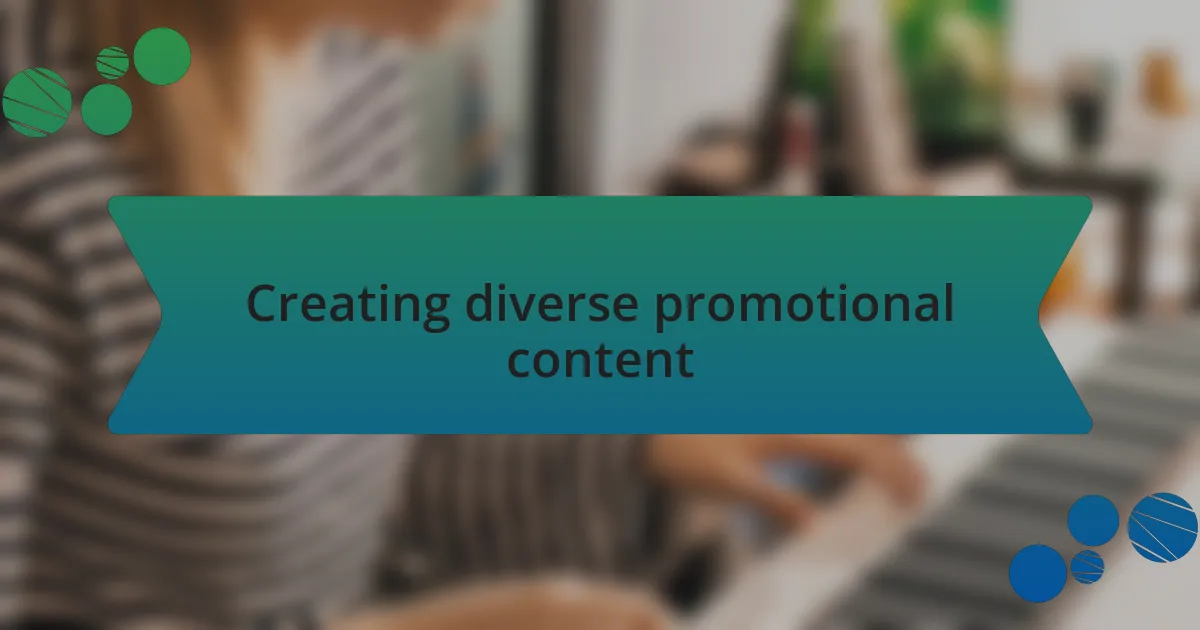
Creating diverse promotional content
Creating diverse promotional content means embracing a wide spectrum of artistic expressions and stories. I recall a project where we collaborated with an artist who blended electronic music with cultural elements from their heritage. By featuring their unique sound and story, we not only celebrated diversity but also drew in listeners who may have felt disconnected from the mainstream scene. Isn’t it fascinating how a single collaboration can spark conversations and connections?
Furthermore, I’ve found that utilizing a variety of formats—such as visual art and written narratives—enhances our promotional content’s richness. One time, we developed a campaign that featured behind-the-scenes videos of artists creating in their own spaces, showcasing their individual journeys. This not only humanized the artists but also resonated with fans who could see the passion and authenticity behind the music. How can we tell stories that resonate on a personal level?
Finally, tapping into community feedback is crucial when creating promotional material. I remember organizing a feedback session after launching a new series featuring diverse artists. The responses were overwhelmingly positive, with many expressing how these stories made them feel seen and valued. Engaging directly with our audience not only fosters loyalty but also ensures that our content genuinely reflects the diversity we aim to celebrate. How often do we pause to listen to the voices that matter most?
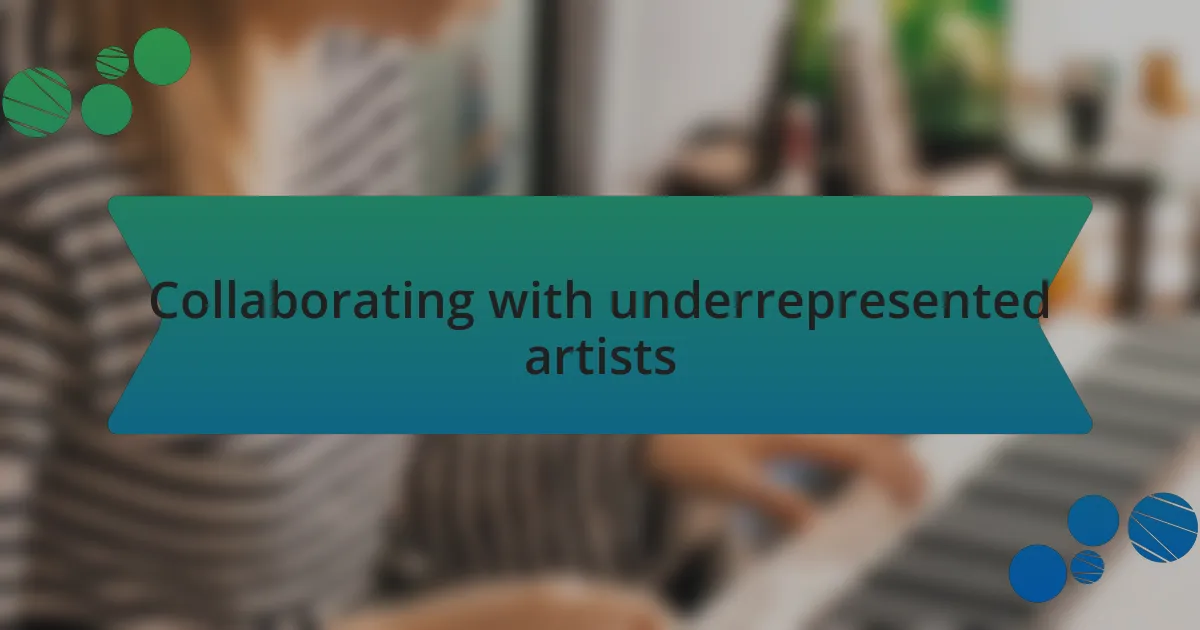
Collaborating with underrepresented artists
Collaborating with underrepresented artists has opened my eyes to the incredible depths of creativity that often go unnoticed. During our partnership with a local female producer, I was struck by how her unique perspective on life’s challenges infused her music with raw emotion and depth. It reminded me that by amplifying these voices, we not only diversify our sound but also broaden our understanding of the world we live in.
I vividly remember when we invited a group of underrepresented artists to co-create a compilation album. The experience was transformative, as each artist contributed their own cultural influences, resulting in a powerful tapestry of sound that celebrated our collective uniqueness. It made me ponder—are we truly appreciating the richness that diverse backgrounds bring to our industry, or are we confining ourselves to a limited narrative?
Moreover, I consider how vital it is to create an environment where underrepresented artists feel safe and valued. One time, I attended an event showcasing emerging talent, and I was genuinely moved by the stories shared by the artists, many of whom struggled to gain visibility in the mainstream. It left me questioning—how can we actively advocate for more inclusive platforms that uplift these voices and inspire future generations?
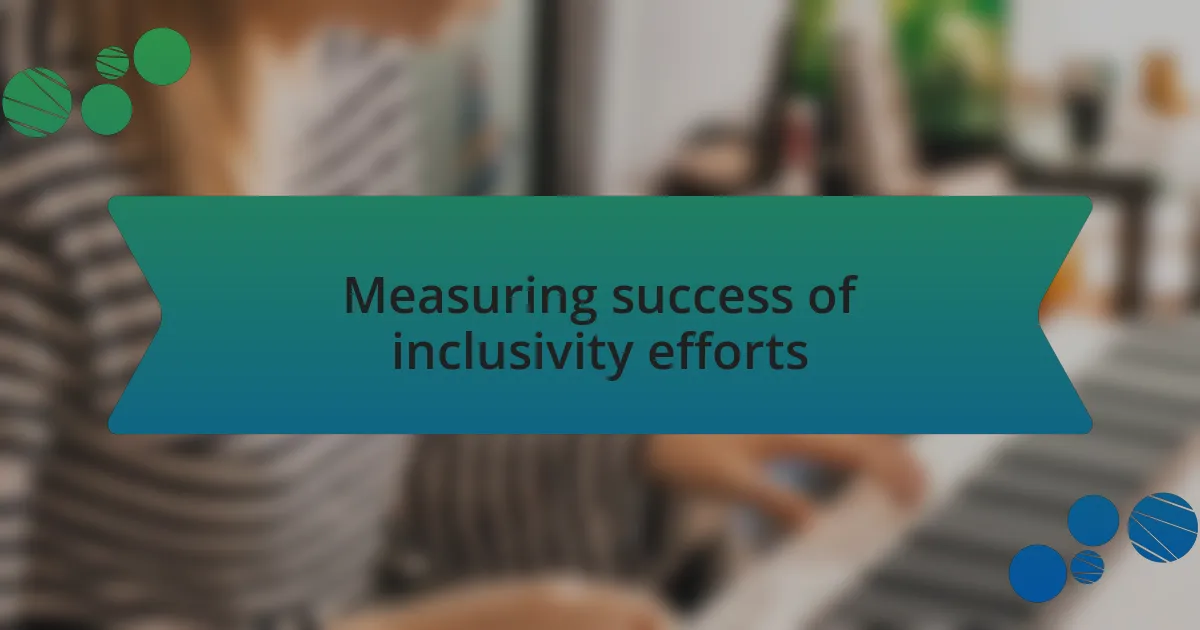
Measuring success of inclusivity efforts
Measuring the success of inclusivity efforts requires a multifaceted approach. For instance, I often track engagement metrics, such as the number of streams and social media interactions from our diverse line-up. When I first analyzed these stats after featuring a range of underrepresented artists, I was elated to see a notable increase in engagement—this data not only validated our choices but encouraged us to continue pushing for more inclusivity.
Feedback from artists is another crucial aspect. Recently, I reached out to an emerging artist after her track release, and her response was overwhelmingly positive; she shared how the recognition made her feel validated and motivated to continue her journey. It made me reflect—how often do we genuinely check in with the artists we promote? Their insights can provide invaluable context to measure our influence and growth in promoting inclusivity.
Moreover, I find community engagement a significant indicator of success. At a recent event, I noticed attendees were not just there for the music but were deeply engaged in discussions about representation in the industry. A conversation sparked between two fans about wanting to see more genres represented felt like a small victory to me. It truly raises the question—are we not only creating spaces for diverse artists but also cultivating awareness and discourse around inclusivity in electronic music?